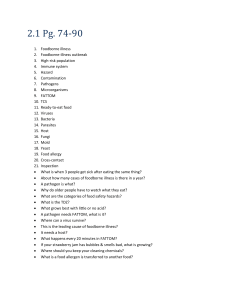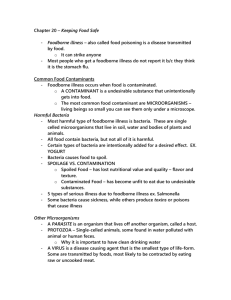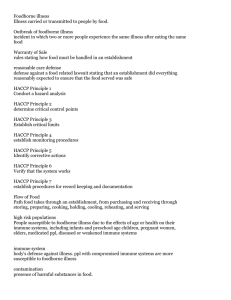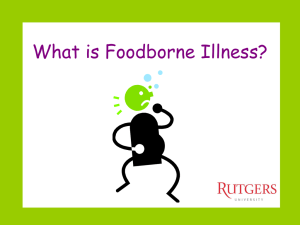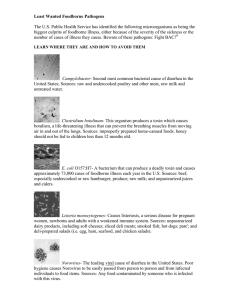Understanding Food Chapter 3: Food Safety
advertisement
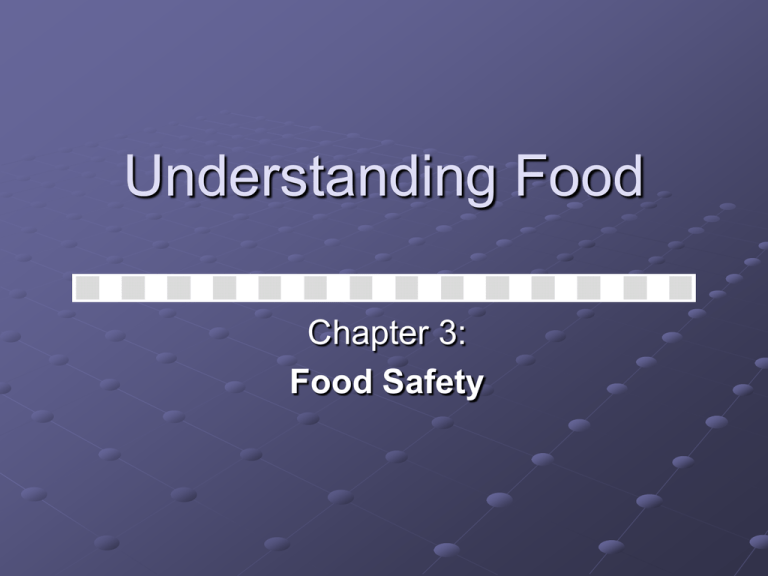
Understanding Food Chapter 3: Food Safety Food Safety The United States food supply is probably the safest in the world Federal and state regulations Inspections Centers for Disease Control and Prevention (CDC) tracks down causal factors upon outbreaks Food manufacturers and distributors are motivated to avoid lawsuits due to negligence Foodborne Illness Outbreak: Defined by the CDC as the occurrence of two or more cases of a similar illness resulting from the ingestion of a common food. Foodborne illness: An illness transmitted to humans by food. Foodborne Illness Foodborne Illness Bacteria: One-celled microorganisms abundant in the air, soil, water, and/or organic matter (i.e., the bodies of plants and animals). Pathogenic: Causing or capable of causing disease. Food infection: An illness resulting from ingestion of food containing large numbers of living bacteria or other microorganisms. Food intoxication: An illness resulting from ingestion of food containing a toxin. Food intoxification: bacteria enters gut and then produces toxin. Foodborne Illness Health agency fingers food in E coli outbreak Food Safety Foodborne Illness Mold: A fungus (a plant that lacks chlorophyll) that produces a furry growth on organic matter. Mycotoxin: A toxin produced by a mold. Bloom: Cottony, fuzzy growth of molds. Virus: An infectious microorganism consisting of RNA or DNA that reproduces only in living cells. Foodborne Illness Food Safety Parasite: An organism that lives on or within another organism at the host’s expense without any useful return. Only 3 out of about 30 types of protozoa are related to food safety: Giardia Cryptosporidium Cyclospora Prion: An infectious protein particle that does not contain DNA or RNA. It is the cause of mad cow disease, or bovine spongiform encephalopathy (BSE). Foodborne Illness HACCP: Hazard Analysis and Critical Control Point System, a systematized approach to preventing foodborne illness during the production and preparation of food. Critical control point (CCP): A point in the HACCP process that must be controlled to ensure the safety of the food. Food Safety HACCP Principle #2: Identify the Critical Control Points (CCPs) Processing (food plants) Purchasing (vulnerable foods) Preparation (thawing, crosscontamination, heating, holding, serving, and cooling/reheating) Cross-contamination: The transfer of bacteria or other microorganisms from one food to another. Sanitation (cleanup, equipment, facilities, pest control, and water) Storage Personnel Food Safety HACCP Principle #3: Establish Limits at Each Critical Control Point The critical control point limits discussed include: Temperature Time Water and humidity pH Food Safety Temperature danger zone: The temperature range of 40° to 140°F (4° to 60°C), which is ideal for bacterial growth. Spore: Encapsulated, dormant form assumed by some microorganisms that is resistant to environmental factors that would normally result in its death. Food Safety Storage Temperatures. Perishable foods should be stored in the refrigerator, freezer, or dry conditions according to the following temperatures: Refrigerator: 40°F (4°C) or below Freezer: below 0°F (18°C) Dry storage: 65°F (18°C) Food Safety Time Microbial growth grows exponentially. Two hour rule applies Storage times Refrigerator Freezer Dry storage Food Safety Water and humidity Bacteria need water to survive pH Acidity or alkalinity often determines which bacteria will grow
